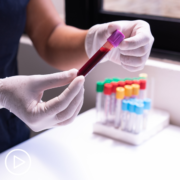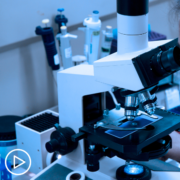What Key Testing Occurs Following an AML Diagnosis?
What Key Testing Occurs Following an AML Diagnosis? from Patient Empowerment Network on Vimeo.
What key tests occur following an AML diagnosis? Dr. Gail Roboz explains the procedures and tests to confirm the diagnosis, assess disease risk, examine AML genetic markers, and develop a treatment plan.
Related Resources:

|

Expert Overview | AML Treatment Options and Phases of Therapy |

|
Transcript:
Dr. Gail Roboz:
We often generally recommend a bone marrow biopsy, even if we know we can make the diagnosis from a blood test, because even though the bone marrow biopsy is not the most fun test in the world, it does offer better information for follow-up care than what you can get initially from the blood.
So, every once in a while, we do have a patient for whom a bone marrow biopsy itself for whatever reason can’t be done. But almost always, we need a bone marrow biopsy, and on that biopsy, you’re going to look under the microscope and see what the cells look like. You’re going to get back standard testing, which is called flow cytometry, which is going to tell the difference between what are the different cells that you’re seeing under the microscope.
But then you’re actually going to get progressively much more fancy testing, including things called chromosomes or cytogenetics, and then ultimately, the majority of patients, if at all possible, will be having mutational testing to identify certain subgroups of AML that benefit from very particular treatments. Next-generation sequencing, PCR, fusion proteins, FISH, cytogenetics, I can go on and on with all kinds of terminology that is very confusing, even to hematology fellows, let alone to patients.
Usually, we use a combination of tests to decide, “Is this patient likely to be able to be cured with chemotherapy alone, or might this patient benefit from a stem cell transplant from somebody else after they go into remission?”
That’s basically what the prognostic scoring systems used to be asking, but now it’s a lot more complicated than that. Because even in the favorable categories, even in the adverse categories, where there used to be very little subtlety, now there is a lot of subtlety.
It’s all about defining getting into remission, and what do I give you once you’re in remission to keep you there? It’s no longer this windshield wiper thing of good, bad, transplant, no transplant. There’s a lot more to AML than there used to be.









